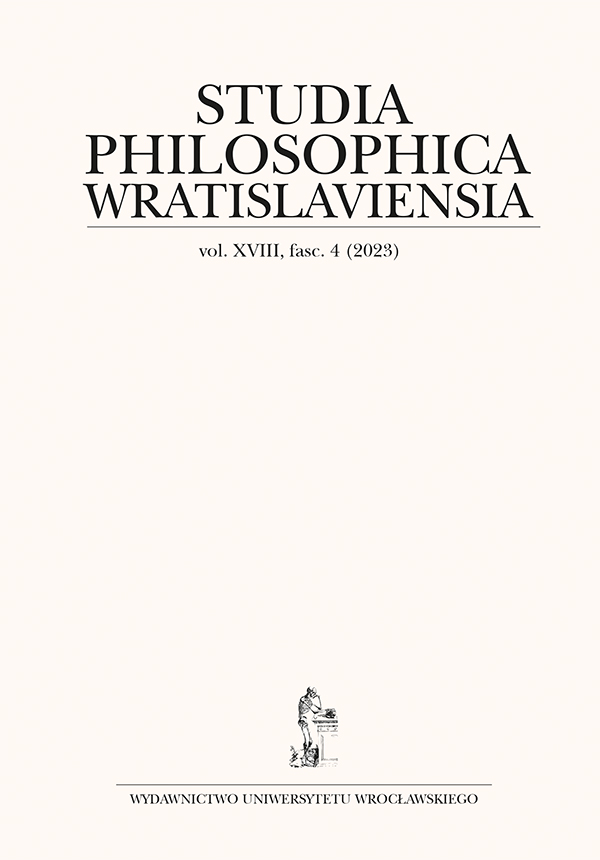

Artykuły

This paper deals explicitly with two competing definitions of wonder. On the one hand, we have something like Mary-Jane Rubenstein’s strange wonder where the very ground on which we stand is shaken and aporias determine our interaction with the world via wonder. We lose the very foundation on which we understand reality and thereby call into question our epistemological grasp of the world. On the other hand, we have Jan B.W. Pedersen’s epistemological wonder where wonder is a kind of surprise or presentation of reality where we are struck by an epistemological lack. Wonder urges us forward in hopes of strengthening and broadening our understanding of the world. Both definitions seem to coalesce in the project of unveiling the reality of the world. Pedersen’s project is explicitly epistemological in that wonder, be it an emotion or some kind of noetic faculty, reveals the world to us in a way that we didn’t know before. Rubenstein, on the other hand, moves beyond epistemology by attempting a kind of strange ontology that opens new possibilities that were not previously accessible. In both versions, we end up peeling away a filmy layer of the world to find some other reality. In this paper, I will argue that there is a tension between wonder and terror that shows up in between Rubenstein’s and Pedersen’s definitions; a kind of wonder that attends to, at least partially, the filmy veil of reality. To do this, I will appeal to Weird fictions, including the virtual reality (VR) game, The Room, to pull at this tension and demonstrate its generativity for thinking through experiences of wonder and terror, including how they frame the meaning of our world(s).
Abumrad J., Krulwich R., Radiolab, June 26, 2014, retrieved July 4, 2023, from https://radiolab.org/podcast/9-volt-nirvana/transcript.
Aldouby H., “Art and Presence: Investigating Embodiment in a Virtual Art Gallery,” [in:] Shifting Interfaces: An Anthology of Presence, Empathy, and Agency in 21st-Century Media Arts, H. Aldouby (ed.), Leuven 2020, pp. 59–73.
Bendik-Keymer J., “Beneficial Relations Between Species & The Moral Responsibility of Wonder,” Environmental Politics (2021), p. 1–18.
Cisco M., Weird Fiction: A Genre Study, Cham 2021.
Cline E., Ready Player One, New York 2011.
Danielsson L., Rosberg S., “Depression Embodied: An Ambiguous Striving Against Fading,” Scandinavian Journal of Caring Sciences 29 (2015), pp. 501–509, https://doi-org.ezaccess.libraries.psu.edu/10.1111/scs.12182.
Fisher M., The Weird and the Eerie, London 2016.
Fisher P., Wonder, the Rainbow, and the Aesthetics of Rare Experiences, Cambridge, Massachusetts 1998.
Kofoed-Ottesen M., “On the Possible Phenomenological Autonomy of Virtual Realities,” Indo-Pacific Journal of Phenomenology 20 (2020), doi: https://doi.org/10.1080/20797222.2020.1857945.
Kurzeck A.K., Kirsch B., Weidinger E., Padberg F., Palm U., “Transcranial Direct Current Stimulation (tDCS) for Depression During Pregnancy: Scientific Evidence and What Is Being Said in the Media—A Systematic Review,” Brain Sciences 8 (2018), doi: 10.3390/brainsci8080155.
Merleau-Ponty M., The Phenomenology of Perception, transl. C. Smith, New York, NY 1962.
Mizer N.J., Tabletop Role-Playing Games and the Experience of Imagined Worlds, Cham 2019.
Pedersen J.B., “Weird Fiction: A Catalyst for Wonder,” [in:] Wonder, Education, and Human Flourishing: Theoretical, Empirical, and Pracital Perspectives, A. Schin- kel (ed.), Amsterdam: VU University Press 2020.
Pinotti A., “Avatars: Shifting Identities in a Genealogical Perspective,” [in:] Shifting Interfaces: An Anthology of Presence, Empathy, and Agency in 21st-Century Media Arts, H. Aldouby (ed.), Leuven 2020, pp. 31–45.
Ramirez E.J., LaBarge S., “Real Moral Problems in the Use of Virtual Reality,” Ethics and Information Technology 20 (2018), pp. 249–263, doi.org/10.1007/s10676-018- 9473-5.
Rubenstein M.-J., Strange Wonder: The Closure of Metaphysics and the Opening of Awe, New York 2008.